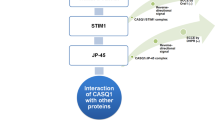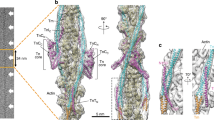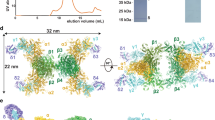Abstract
Calsequestrin, the major Ca2+ storage protein of muscle, coordinately binds and releases 40–50 Ca2+ ions per molecule for each contraction-relaxation cycle by an uncertain mechanism. We have determined the structure of rabbit skeletal muscle calsequestrin. Three very negative thioredoxin-like domains surround a hydrophilic center. Each monomer makes two extensive dimerization contacts, both of which involve the approach of many negative groups. This structure suggests a mechanism by which calsequestrin may achieve high capacity Ca2+ binding. The suggested mechanism involves Ca2+-induced collapse of the three domains and polymerization of calsequestrin monomers arising from three factors: N-terminal arm exchange, helix–helix contacts and Ca2+ cross bridges. This proposed structure-based mechanism accounts for the observed coupling of high capacity Ca2+ binding with protein precipitation.
This is a preview of subscription content, access via your institution
Access options
Subscribe to this journal
Receive 12 print issues and online access
$189.00 per year
only $15.75 per issue
Buy this article
- Purchase on Springer Link
- Instant access to full article PDF
Prices may be subject to local taxes which are calculated during checkout
Similar content being viewed by others
References
Yano, K. & Zarain-Herzberg, A. Sarcoplasmic reticulum calsequestrins: structural and functional properties. Mol. Cell Blochem. 135, 61–70 (1994).
Ikemoto, N., Antoniu, B., Kang, J.J., M'esz'aros, L.G. & Ronjat, M. Intravesicular calcium transient during calcium release from Sarcoplasmic reticulum. Biochemistry 30, 5230–5237 (1991).
Kawasaki, T. & Kasai, M. Regulation of calcium channel in Sarcoplasmic reticulum by calsequestrin. Biochem. Biophys. Res. Common. 199, 1120–1127 (1994).
MacLennan, D.H. & Wong, P.T. Isolation of a calcium-sequestering protein from Sarcoplasmic reticulum. Proc. Natl. Acad. Sci. USA 68, 1231–1235 (1971).
MacLennan, D.H., Campbell, K.P. & Reithmeier, R.A.F. Calsequestrin, Calcium and Cell Function 4, 151–173 (1983).
Somlyo, A.V., Gonzalez-Serratos, H., Shuman, H., McClennan, G. & Somlyo, A.P. Calcium release and ionic changes in the Sarcoplasmic reticulum of tetanized muscle: an electron-probe study. J. Cell Biol. 90, 577–594 (1981).
Lytton, J. & MacLennan, D.H. In the heart and cardiovascular system. (eds H. A. 40. Fozzard, E. Harber, R. B. Jennings, A. M. Katz & H. E. Morgan) 1203–1222 (Raven Press Ltd., New York; 1992).
Mitchell, R.D., Simmerman, H.K.B. & Jones, L.R. Ca2+ binding effects on protein conformation and protein interactions of canine cardiac calsequestrin. J. Biol. Chem. 263, 1376–1381 (1988).
Guo, W. & Campbell, K.P. Association of triadin with the ryanodine receptor and calsequestrin in the lumen of the Sarcoplasmic reticulum. J. Biol. Chem. 270, 9027–9030 (1995).
Fliegel, L. Amino acid sequence of rabbit fast-twitch skeletal muscle calsequestrin deduced from cDNA and peptide sequencing. Proc. Natl. Acad. Sci. USA 84, 1167–1171 (1987).
Fujii, J., Wiilard, H.F. & MacLennan, D.H. Characterization and localization to human chromosome 1 of human fast-twitch skeletal muscle calsequestrin gene. Somat. Cell. Mol. Genet. 16 185–189 (1990).
Choi, E.S. & Clegg, D.O. Identification and developmental expression of a chicken calsequestrin homolog. Dev. Biol. 142, 169–177 (1990).
Arai, M., Alpert, N.R. & Periasamy, M. Cloning and characterization of the gene encoding rabbit cardiac calsequestrin. Gene 109, 275–279 (1991).
Treves, S., Vilsen, B., Chiozzi, P., Andersen, J.P. & Zorzato, F. Molecular cloning, functional expression and tissue distribution of the cDNA encoding frog skeletal muscle calsequestrin. Biochem. J. 283, 767–772 (1992).
Zarain-Herzberg, A., Fliegel, L. & MacLennan, D.H. Structure of the rabbit fast-twitch skeletal muscle calsequestrin gene. J. Biol. Chem. 263, 4807–4812 (1988).
Scott, B.T., Simmerman, H.K., Collins, H.J., Nadal-Ginard, B. & Jones, L.R. Complete amino acid sequence of canine cardiac calsequestrin deduced by cDNA cloning. J. Biol. Chem. 263, 8958–8964 (1988).
Ikemoto, N., Nagy, B., Bhatnagar, G.M. & Gergely, J. Studies on a metal-binding protein of the Sarcoplasmic reticulum. J. Biol. Chem. 249, 2357–2365 (1974).
Ostwald, T.J., MacLennan, D.H. & Dorrington, K.J. Effects of cation binding on the conformation of calsequestrin and the high affinity calcium-binding protein of Sarcoplasmic reticulum. J. Biol. Chem. 249. 5867–5871 (1974).
Aaron, B.M., Oikawa, K., Reithmeier, R.A. & Sykes, B.D. Characterization of skeletal muscle calsequestrin by 1H NMR spectroscopy. J. Biol. Chem. 259, 11876–11881 (1984).
He, Z., Dunker, A.K., Wesson, C.R. & Trumble, W.R. Ca(2+)-induced folding and aggregation of skeletal muscle Sarcoplasmic reticulum calsequestrin. The involvement of the trifluoperazine-binding site. J. Biol. Chem. 268, 24635–24641 (1993).
Ikemoto, N., Bhatnagar, G.M., Nagy, B. & Gergely, J. Interaction of divalent cations with the 55,000-dalton protein component of the Sarcoplasmic reticulum. Studies of fluorescence and circular dichroism. J. Biol. Chem. 247, 7835–7837 (1972).
Cozens, B. & Reithmeier, R.A. Size and shape of rabbit skeletal muscle calsequestrin. J. Biol. Chem. 259, 6248–6252 (1984).
Williams, R.W. & Beeler, T.J. Secondary structure of calsequestrin in solutions and in crystals as determined by Raman spectroscopy. J. Biol. Chem. 261, 12408–12413 (1986).
Ohnishi, M. & Rethmeier, R.A. Fragmentation of rabbit skeletal muscle calsequestrin: spectral and ion binding properties of the carboxyl-terminal region. Biochemistry 26, 7458–7465 (1987).
Jorgensen, A.O., Shen, A.C., Campbell, K.P. & Maclennan, D.H. Ultrastructural localization of calsequestrin in rat skeletal muscle by immunoferritin labeling of ultrathin frozen sections. J. Cell Biol. 97, 1573–1581 (1983).
Hidalgo, C., Donoso, P. & Rodrigues, R.H. Protons induce calsequestrin conformational changes. Biophys. J. 71, 2130–2137 (1996).
Strynadka, N.C. and James, M.N. Crystal structures of the helix-loop-helix calcium-binding proteins. Anno. Rev. Biochem. 58, 951–998 (1989).
Wright, D.L., Holloway, J.H. & Reilley, C.N. Anal. Chem. 37, 884 (1965).
Krause, K.H., Milos, M., Luan-Rilliet, Y., Lew, D.P. & Cox, J.A. Thermodynamics of cation binding to rabbit skeletal muscle calsequestrin. Evidence for distinct Ca(2+)- and Mg(2+)-binding sites. J. Biol. Chem. 266, 9453–9459 (1991).
Maurer, A., Tanaka, M., Ozawa, T. & Fleischer, S. Purification and crystallization of the calcium binding protein of Sarcoplasmic reticulum from skeletal muscle. Proc. Nat. Acad. Sci. USA 82, 4036–4040 (1985).
Hayakawa, K. et al. Crystallization of canine cardiac calsequestrin. J. Mol. Biol. 235, 357–360 (1994).
Katti, S.K., LeMaster, D.M. & Eklund, H. Crystal structure of thioredoxin from Escherichia coli at 1.68 Å resolution. J. Mol. Biol. 212, 167–184 (1990).
Martin, J.L., Bardwell, J.C. & Kuriyan, J. Crystal structure of the DsbA protein required for disulphide bond formation in vivo. Nature 365, 4640–468 (1993).
Hu, S.H., Peek, J.A., Rattigan, E., Taylor, R.K. & Martin, J.L. Structure of TcpG, the DsbA protein folding catalyst from Vibrio cholerae. J. Mol. Biol. 268, 137–146 (1997).
Lytton, J. & Nigam, S.K. Intracellular calcium: molecules and pools. Curr. Opin. Cell. Biol. 4, 220–226 (1992).
Van, P.N., Rupp, K., Lampen, A. & Soling, H.D. CaBP2 is a rat homolog of ERp72 with proteindisulfide isomerase activity. Eur. J. Biochem. 213, 789–795 (1993).
Sonnichsen, B. et al. Retention and retrieval: both mechanisms cooperate to maintain calreticulin in the endoplasmic reticulum. J. Cell. Sci. 107, 2705–2717 (1994).
Darby, N.J., Kemmink, J. & Creighton, T.E. Identifying and characterizing a structural domain of protein disulfide isomerase. Biochemistry 35, 10517–10528 (1996).
Branden, C. Relation between structure and function of α/β proteins. Q. Rev. Biophys. 13, 317–338 (1980).
Burley, S.K. and Petsko, G.A. Aromatic-aromatic interaction: a mechanism of protein structure stabilization. Science 229, 23–28 (1985).
Franzini-Armstrong, C., Kenney, L.J. & Varriano-Marston, E. The structure of calsequestrin in triads of vertebrate skeletal muscle: a deep-etch study. J. Cell. Biol. 105, 49–56 (1987).
Saito, A., Seller, S., Chu, A. & Fleischer, S. Preparation and morphology of Sarcoplasmic reticulum terminal cisternae from rabbit skeletal muscle. J. Cell. Biol. 99, 875–885 (1984).
Maurer, A., Tanaka, M., Ozawa, T. & Fleischer, S. Purification and crystallization of calcium-binding protein from skeletal muscle Sarcoplasmic reticulum. Meths Enz. 157, 321–328 (1988).
Bennet, M.J., Schlunegger, M.P. & Eisenberg, D. 3D domain swapping: a mechanism for oligomer assembly. Protein Sci. 4, 2455–2468 (1995)
Bergdoll, M., Remy, M.H., Cagnon, C., Masson, J.M. & Dumas, P. Proline-dependent oligomerization with arm exchange. Structure 5. 391–401 (1997).
Nurizzo, D. et al. N-terminal arm exchange is observed in the 2.15 Å crystal structure of oxidized nitrite reductase from Pseudomonas aeruginosa. Structure 5, 1157–1171 (1997).
Zhang, L., Kelley, J., Schmeisser, G., Kobayashi, Y.M. & Jones, L.R. Complex formation between junctin, triadin, calsequestrin, and the ryanodine receptor. Proteins of the cardiac junctional Sarcoplasmic reticulum membrane. J. Biol. Chem. 272, 23389–23397 (1997).
Levin, R.M. & Weiss, B. Binding of trifluoperazine to the calcium-dependent activator of cyclic nucleotide phosphodiesterase. Mol. Pharmacol. 13, 690–697–(1977).
Cachia, P.J., Gariepy, J. & Hodges, R.S. In Calmodulin antagonists and cellular physiology. (eds Hidaka, H., & Hartshorne, D.J.) 63–88 (Academic Press, Inc., Orlando, Florida; 1985).
Gari'epy, J. & Hodges, R.S. Localization of a trifluoperazine binding site on troponin C. Biochemistry 22. 1586–1594 (1983).
Payne, M.E. et al. Calcium/calmodulin-dependent protein kinase II. Characterization of distinct calmodulin binding and inhibitory domains. J. Biol. Chem. 263, 7190–7195–(1988).
Kelly, P.T., Weinberger, R.P. & Waxham, M.N. Active site-directed inhibition of Ca2+/calmodulin-dependent protein kinase type II by a bifunctional calmodulin-binding peptide. Proc. Natl. Acad. Sci. USA 85, 4991–4995 (1988).
Colbran, R.J., Fong, Y.L., Schworer, C. & Soderling, T.R. Regulatory interactions of the calmodulin-binding, inhibitory, and autophosphorylation domains of Ca2+/calmodulin-dependent protein kinase II. J. Biol. Chem 263, 18145–18151 (1988).
Blumenthal, D.K. et al. Identification of the calmodulin-binding domain of skeletal muscle myosin light chain kinase. Proc. Natl. Acad. Sci. USA 82, 3187–3191–(1985).
Cook, W.J., Walter, L.J. & Walter, M.R. Drug binding by calmodulin: crystal structure of a calmodulin-trifluoperazine complex. Biochemistry 33, 15259–15265 (1994).
Ikura, M. et al. Solution structure of a calmodulin-target peptide complex by multidimensional NMR. Science 256, 632–638 (1992).
Meador, W.E., Mean, A.R. & Quiocho, F.A. Target enzyme recognition by calmodulin: 2.4 Å structure of a calmodulin-peptide complex. Science 257, 1251–1255 (1992).
Meador, W.E., Mean, A.R. & Quiocho, F.A. Modulation of calmodulin plasticity in molecular recognition on the basis of x-ray structures. Science 262, 1718–1721 (1993).
Furey, W. & Swanminathan, S. PHASES-95: a program package for the processing and analysis of diffraction data from macromolecules. Meths Enz. 277, 590–620 (1997).
Wang, B.C. Resolution of phase ambiguity in macromolecular crystallography. Meths Enz. 115, 90–112 (1985).
Jones, T.A., Zou, J.Y., Cowan, S. & W., Kjeldgaard, M. Improved methods for binding protein models in electron density maps and the location of errors in these models. Acta Crystallogr. A 47, 110–119 (1991).
Brunger, A.T. X-PLOR A system for crystallography and NMR (Version 3.1) (Yale University, New Haven, Connecticut; 1992).
Kraulis, P. MOLSCRIPT: a program to produce both detailed and schematic plots of protein structure. J. Appl. Crystallogr. 24, 946–950 (1991).
Nicholls, A., Sharp, K.A. & Honig, B. Protein folding and association: insights from the interfacial and thermodynamic properties of hydrocarbons. Proteins: Struct. Funct. and Genet. 11, 281–296 (1991).
Bacon, D.J. & Anderson, W.F. A fast algorithm for rendering space filling molecular pictures. J. Mol. Graphics. 6, 219–222 (1988).
Meritt, E.A. & Murphy, M.E.P. Raster3D Version 2.0. A Program for Photorealistic Molecular Graphics. Acta Crystallogr. D. 50, 869–873 (1994).
Author information
Authors and Affiliations
Rights and permissions
About this article
Cite this article
Wang, S., Trumble, W., Liao, H. et al. Crystal structure of calsequestrin from rabbit skeletal muscle sarcoplasmic reticulum. Nat Struct Mol Biol 5, 476–483 (1998). https://doi.org/10.1038/nsb0698-476
Received:
Accepted:
Issue Date:
DOI: https://doi.org/10.1038/nsb0698-476
This article is cited by
-
The function and regulation of calsequestrin-2: implications in calcium-mediated arrhythmias
Biophysical Reviews (2022)
-
Calsequestrin, a key protein in striated muscle health and disease
Journal of Muscle Research and Cell Motility (2021)
-
The structure of a calsequestrin filament reveals mechanisms of familial arrhythmia
Nature Structural & Molecular Biology (2020)
-
Phylogenetic and biochemical analysis of calsequestrin structure and association of its variants with cardiac disorders
Scientific Reports (2020)
-
Calsequestrin: a well-known but curious protein in skeletal muscle
Experimental & Molecular Medicine (2020)



